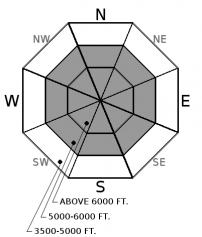| Sunday | Sunday Night | Monday | |
|---|---|---|---|
| Cloud Cover: | Mostly cloudy and mild | Partial clearing and cool | Partly sunny and cooler |
| Temperatures: | 29 to 34 deg. F. | 15 to 20 deg. F. | 27 to 32 deg. F. |
| Wind Direction: | W | E | E |
| Wind Speed: | 1 to 11 mph with gusts to 16 | 1 to 11 mph | 1 to 11 mph with gusts to 20 |
| Snowfall: | 0 in. | 0 in. | 0 in. |
| Snow Line: |
Whitefish Range
How to read the forecast
Elevated avalanche conditions remain due to recent dense surface snow resting on lower density snow. Natural avalanche activity has diminished but a human triggered storm slab is possible on slopes steeper than 35 degrees at mid and upper elevations. In areas that harbor a shallow snowpack It remains possible to trigger a very large avalanche on buried weak layers. Evaluate the snow structure before committing to a slope and continue to practice safe travel techniques.

2. Moderate
?
Above 6500 ft.
2. Moderate
?
5000-6500 ft.
2. Moderate
?
3500-5000 ft.
- 1. Low
- 2. Moderate
- 3. Considerable
- 4. High
- 5. Extreme
-
Type ?
-
Aspect/Elevation ?

-
Likelihood ?CertainVery LikelyLikelyPossible
 Unlikely
Unlikely -
Size ?HistoricVery LargeLargeSmall

The dense snowfall Friday evening/Saturday morning was deposited on lower density snow creating an upside down storm layer. Observations found this layer to be reactive in the southern Whitefish Range where natural and human triggered slides occurred. Natural activity has decreased but a human triggered slide is still possible on slopes steeper than 35º. At mid elevations this surface snow is resting on a rain crust which could act as a slippery bed surface. This is a snow surface problem and identifiable by cracking or collapsing under your feet or machine with hand pits identifying this snow structure. Test small inconsequential slopes before committing to larger steeper terrain and continue to use caution around terrain traps, steep rollovers, or in isolated wind-loaded slopes or gullies.
-
Type ?
-
Aspect/Elevation ?

-
Likelihood ?CertainVery LikelyLikelyPossible
 Unlikely
Unlikely -
Size ?HistoricVery LargeLargeSmall

Observations from the Whitefish Range were limited yesterday and we do not know if the persistent slab problem "woke up" from our most recent snowfall. Areas that harbor a thin snowpack of less than 4' depth, such as the northern Whitefish Range or steep mid elevation terrain such as the Skook Chutes, are most susceptible to human triggering due to the poor snowpack structure consisting of facets and crust(s). This weeks storm cycle has stressed the weak layers buried near the bottom of our pack and they may be more reactive to the weight of a rider or their machine. Be alert for obvious signs of instability such as collapses or shooting cracks and in areas where a weak snow structure exists it is best to default to lower angle terrain and avoid convex rollovers.
This weeks storm cycle ended with a bang Friday night/ Saturday with dense snowfall deposited on low density snow. 24 hour totals included 2.0" of SWE at the Noisy Basin Snotel in the Swan Range and up to 18" of snow at 6000' in the western Flathead Range. Observations were limited yesterday, but FAC staff noted a tender surface snowpack in the southern Whitefish Range with both natural and human triggered storm slabs up to 1 foot thick on steep terrain. A much larger avalanche cycle was observed in the western Flathead Range (see this observation) where both storm slabs and persistent slab avalanches occurred. We have listed the Persistent Slab problem in our daily advisory for the past 3 weeks but had seen little activity associated with these buried facet/crust layers. Avalanche activity yesterday confirms that we still have a weak snowpack structure capable of producing very large destructive avalanches in the Flathead and Whitefish Range along with southern Glacier Park. Be diligent with snowpack evaluations, practice cautious route-finding with conservative decision-making essential when managing the uncertainty around this problem.
High pressure will continue to build over the region today and breaks in the cloud cover will be possible in some areas this afternoon. Starting tonight into Monday, a disturbance passing to our east will bring an increase in easterly winds across western Monday and possibly a few light snow showers near the Continental Divide.
This advisory applies only to backcountry areas outside established ski area boundaries. This advisory describes general avalanche conditions and local variations always occur. This advisory expires at midnight on the posted day unless otherwise noted. The information in this advisory is provided by the USDA Forest Service who is solely responsible for its content.



























